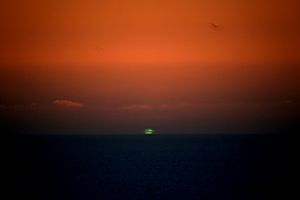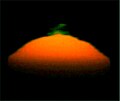Green flash
From Wikipedia, the free encyclopedia
Green flashes and green rays are optical phenomena that occur shortly after sunset or before sunrise, when a green spot is visible for a short period of time above the sun, or a green ray shoots up from the sunset point. Green flashes are actually a group of phenomena stemming from different causes, and some are more common than others.[1] Green flashes can be observed from any altitude (even from an aircraft). They are usually seen at an unobstructed horizon, such as over the ocean, but are possible over cloud-tops and mountain-tops as well.
Contents |
[edit] Explanation
The reason for a green flash lies in refraction of light (as in a prism) in the atmosphere: light moves more slowly in the lower, denser air than in the thinner air above, so sunlight rays follow paths that curve slightly, in the same direction as the curvature of the Earth. Higher frequency light (green/blue) curves more than lower frequency light (red/orange), so green/blue rays from the upper limb of the setting sun remain visible after the red rays are obstructed by the curvature of the earth.
Green flashes are enhanced by mirage, which increase the density gradient in the atmosphere, and therefore increase refraction. A green flash is more likely to be seen in clear air, when more of the light from the setting sun reaches the observer without being scattered. We might expect to see a blue flash, but the blue is preferentially scattered out of our line of sight and remaining light ends up looking green.
With slight magnification a green rim on the top limb of the solar disk can be seen on most clear-day sunsets. However the flash or ray effects require a stronger layering of the atmosphere and a mirage which serves to magnify the green for a fraction of a second to a couple of seconds.
[edit] Types of green flashes
The green flash is actually a group of phenomena, some of which are listed below:[1]
| Type | Characteristics | Conditions | Best seen from... |
|---|---|---|---|
| Inferior-mirage flash | Joule's "last glimpse"; oval, flattened below. Lasts 1 or 2 seconds. | Surface warmer than the overlying air | Close to sea level |
| Mock-mirage flash | Indentations seem to "pinch off" a thin, pointy strip from the upper limb of the Sun. Lasts 1 or 2 seconds. | Atmospheric inversion layer below eye level; surface colder than air. | The higher the eye, the more likely; flash is most obvious when the eye is just above the inversion. |
| Sub-duct flash | Large upper part of an hourglass-shaped Sun turns green for up to 15 seconds. | Observer below a strong atmospheric inversion | In a narrow height interval just below a duct (can occur at any height) |
| Green ray | Green beam of light either shooting up or seen immediately after sundown. Usually few degrees long, lasting several seconds. | Hazy air and a bright green flash acting as a light source | Unknown |
The majority of flashes observed are inferior-mirage or mock-mirage ones, with the others constituting only 1% of reports. Some types not listed in the table above, such as the cloud-top flash (seen as the sun sinks into a coastal fog, or at distant cumulus clouds), are not understood.[1]
[edit] Blue flashes
Very occasionally, the amount of blue light is sufficient to be visible as a "blue flash".[2] The term should not be confused with the similar usage of blue flash referring to the blue light seen in nuclear criticality accidents.
[edit] Green rim
As an astronomical object sets or rises, the light it emits travels through the atmosphere, which works as a prism separating the light into different colors. The color of the upper limb of an astronomical object could go from blue to green to violet depending on the decrease in concentration of pollutants as they spread throughout an increasing volume of atmosphere.[3], The lower limb of an astronomical object is always red.
A green rim is very thin, and is difficult or impossible to see with the naked eye. In usual conditions a green rim of an astronomical object gets fainter, when an astronomical object is very low above the horizon because of atmospheric reddening,[4] but sometimes the conditions are right to see a green rim just above the horizon. The following quote describes probably the longest green rim, which at times could have been a green flash, observation. It was seen on and off for 35 long minutes by members of the Richard Evelyn Byrd party from the Little America exploration base. Often a green rim changes to a green flash and back again during the same sunset. The image below is an illustration of what members of the Richard Evelyn Byrd party from the Little America exploration base may have seen. [5][6]

SEEN FOR HALF HOUR
There was a rush for the surface and as eyes turned southward, they saw a tiny but brilliant green spot where the last ray of the upper limb of the sun hung on the skyline. It lasted an appreciable length of time, several seconds at least, and no sooner disappeared than it flashed forth again. Altogether it remained on the horizon with short interruptions for thirty-five minutes.
When it disappeared momentarily it seemed to have been shut off by a tiny spurt, an inequality in the skyline caused by the barrier surface.
Even by moving the head up a few inches it would disappear and reappear again and after it had finally disappeared from view it could be recaptured by climbing up the first few steps of the antanea antenna [sic] post.
To see green rim on and off for 35 minutes there had to be some mirage present.
There's an interesting situation with green rim observing. Green rim is present every sunset, but it is too thin to be seen with the naked eye. The best time to observe a green rim is about 10 minutes before sunset.[4] It is too early to use any magnification like binoculars or a telescope to look right at the Sun. (Of course, a magnified image might be projected onto a sheet of paper for safe viewing.) When the sun gets closer to the horizon, the green rim is becoming fainter because of atmospheric reddening.[4] According to the above it is probably correct to conclude that although a green rim is present during every sunset, a green flash is more rare because it requires a mirage to be present.
[edit] Green flashes in fiction

This phenomenon features as a major plot device in the Walt Disney Pictures film Pirates Of The Caribbean: At World's End. In the movie's back story, the green flash is fictionalized, becoming an occurrence of legendary quality that is rumored to signify a soul returning from the dead. Later in the film, this concept is further expanded, and the flash is revealed to signal when a trapped spirit escapes from its imprisonment in Davy Jones's Locker, a feat achieved by the film's main characters. However, the size and scale of the flash depicted in the film is greatly exaggerated.
This phenomenon is also referred to in a novel called The Green Ray by Jules Verne, a novel called Smith and the Pharaohs by H. Rider Haggard, a novel called Don't Stop the Carnival by Herman Wouk, and in a film by Éric Rohmer called Le rayon vert and a 2008 film directed by Paul Nihipali, Green Flash.
| Wikimedia Commons has media related to: Green Flash |
The green flash is also briefly mentioned in M. K. Wren's "A Gift Upon the Shore", a mythic story of survival after a nuclear holocaust.
In the book Flush seeing the green flash is described as a family goal.
In the book The Pride of the Peacock by Victoria Holt, a large opal named "The Green Flash at Sunset" is the titular treasure. The opal is so named due to a glint of green that may be rarely seen in certain light and at a certain angle to the gem.
[edit] References
- ^ a b c Young, A. (2006). "Green flashes at a glance". http://mintaka.sdsu.edu/GF/papers/Zenit/glance.html. Retrieved on 2009-03-05.
- ^ "The Green Flash, BBC Weather online. Retrieved on 09/05/07.
- ^ Dispersive refraction by webexhibits.org
- ^ a b c Green and red rims by Andy Young
- ^ Owen, R (1929). San Francisco Chronicle. pp. 5.
- ^ Andrew, Young. Annotated bibliography of mirages, green flashes, atmospheric refraction, etc.. http://mintaka.sdsu.edu/GF/bibliog/bibliog.html.
[edit] See also
[edit] External links
- A Green Flash Page, Andrew T. Young's page with comprehensive explanations and simulations.
- Green Flash - Atmospheric Optics, explanations and image gallery, Les Cowley's Atmospheric Optics site.
- A Green Flash from Astronomy Picture of the Day, NASA.
- Green flash picture released by the European Southern Observatory (ESO) May 2, 2008. Conditions for seeing green flashes are nearly ideal at the ESO in Chile, and they are seen regularly.
[edit] Gallery
|
Mock mirage sunset and green flash |
Some green flashes observed in San Francisco in 2007 |
Some green flashes observed in San Francisco in 2007 |
|
|
Inferior mirage green flash |
|||
|
Mock mirage green flashes in the same sunset |
Mock mirage green flashes in the same sunset |
||




















